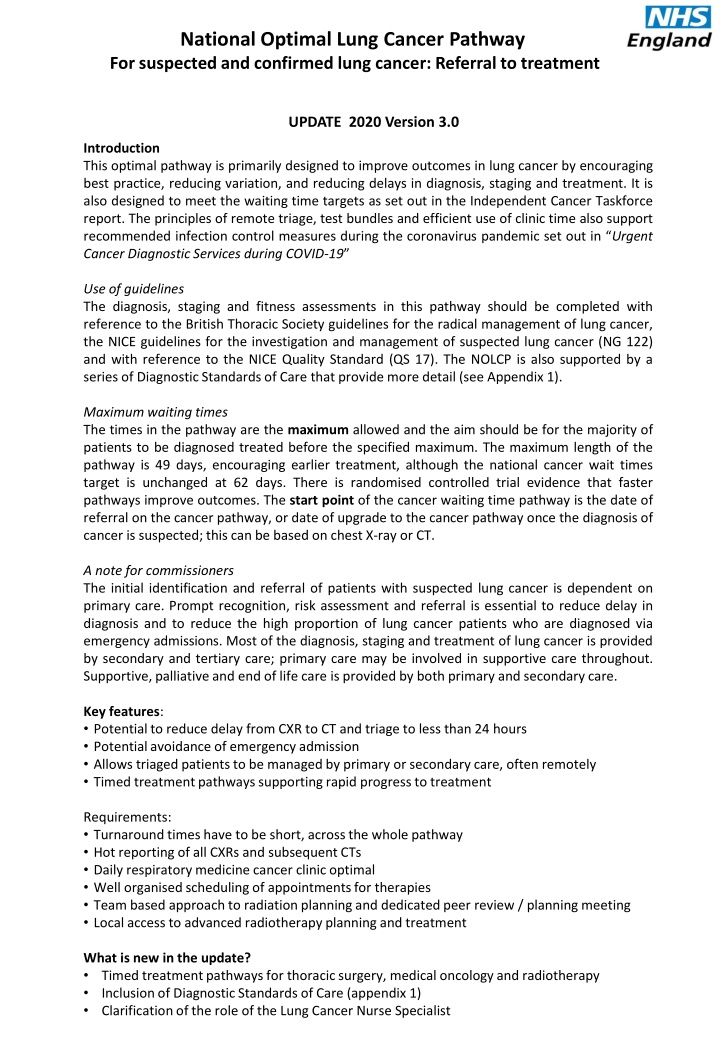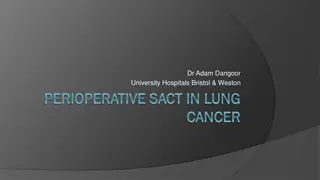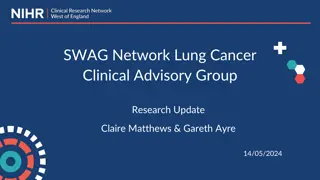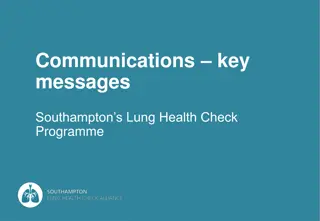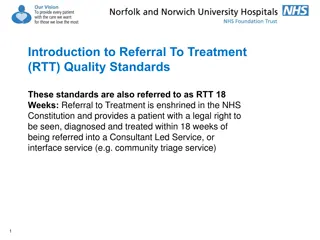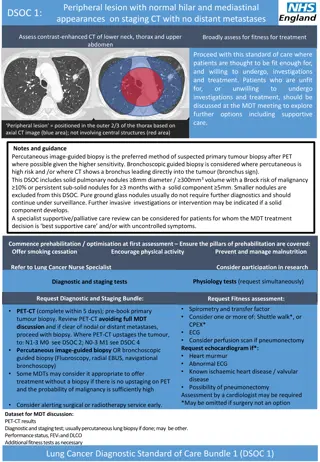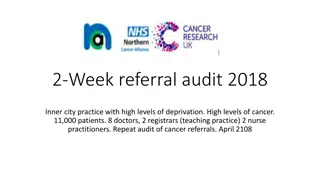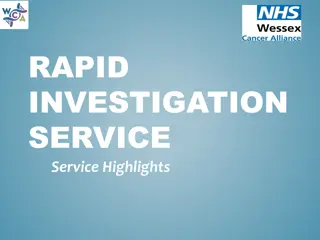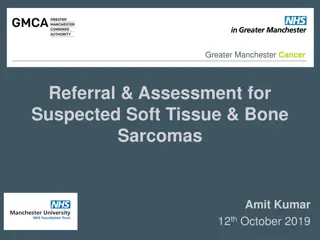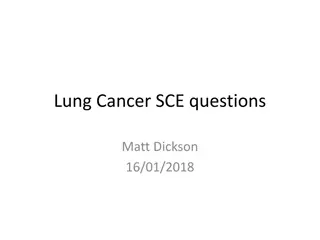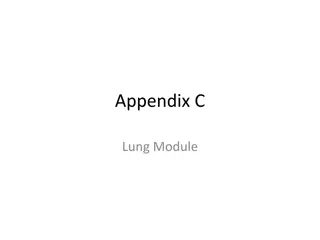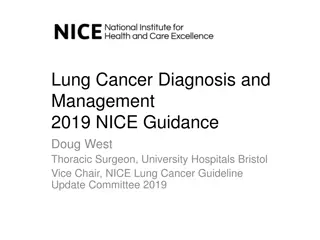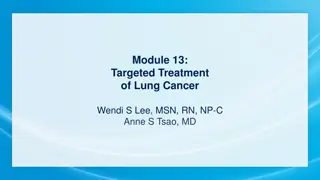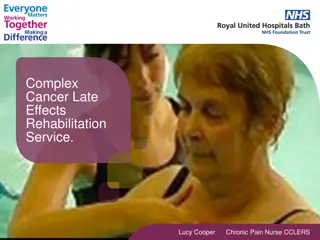National Optimal Lung Cancer Pathway: Referral to Treatment Update 2020 Version 3.0
This optimal pathway aims to improve outcomes in lung cancer by reducing delays in diagnosis, staging, and treatment, while meeting waiting time targets. It emphasizes remote triage, test bundles, and efficient clinic use. The pathway includes maximum waiting times, timely treatment pathways, and guidelines for diagnosis and staging. Key features include reducing delays in CXR to CT triage and potential avoidance of emergency admissions. The update introduces timed treatment pathways, Diagnostic Standards of Care, and clarifies the role of Lung Cancer Nurse Specialists.
Download Presentation

Please find below an Image/Link to download the presentation.
The content on the website is provided AS IS for your information and personal use only. It may not be sold, licensed, or shared on other websites without obtaining consent from the author.If you encounter any issues during the download, it is possible that the publisher has removed the file from their server.
You are allowed to download the files provided on this website for personal or commercial use, subject to the condition that they are used lawfully. All files are the property of their respective owners.
The content on the website is provided AS IS for your information and personal use only. It may not be sold, licensed, or shared on other websites without obtaining consent from the author.
E N D
Presentation Transcript
National Optimal Lung Cancer Pathway For suspected and confirmed lung cancer: Referral to treatment UPDATE 2020 Version 3.0 Introduction This optimal pathway is primarily designed to improve outcomes in lung cancer by encouraging best practice, reducing variation, and reducing delays in diagnosis, staging and treatment. It is also designed to meet the waiting time targets as set out in the Independent Cancer Taskforce report. The principles of remote triage, test bundles and efficient use of clinic time also support recommended infection control measures during the coronavirus pandemic set out in Urgent Cancer Diagnostic Services during COVID-19 Use of guidelines The diagnosis, staging and fitness assessments in this pathway should be completed with reference to the British Thoracic Society guidelines for the radical management of lung cancer, the NICE guidelines for the investigation and management of suspected lung cancer (NG 122) and with reference to the NICE Quality Standard (QS 17). The NOLCP is also supported by a series of Diagnostic Standards of Care that provide more detail (see Appendix 1). Maximum waiting times The times in the pathway are the maximum allowed and the aim should be for the majority of patients to be diagnosed treated before the specified maximum. The maximum length of the pathway is 49 days, encouraging earlier treatment, although the national cancer wait times target is unchanged at 62 days. There is randomised controlled trial evidence that faster pathways improve outcomes. The start point of the cancer waiting time pathway is the date of referral on the cancer pathway, or date of upgrade to the cancer pathway once the diagnosis of cancer is suspected; this can be based on chest X-ray or CT. A note for commissioners The initial identification and referral of patients with suspected lung cancer is dependent on primary care. Prompt recognition, risk assessment and referral is essential to reduce delay in diagnosis and to reduce the high proportion of lung cancer patients who are diagnosed via emergency admissions. Most of the diagnosis, staging and treatment of lung cancer is provided by secondary and tertiary care; primary care may be involved in supportive care throughout. Supportive, palliative and end of life care is provided by both primary and secondary care. Key features: Potential to reduce delay from CXR to CT and triage to less than 24 hours Potential avoidance of emergency admission Allows triaged patients to be managed by primary or secondary care, often remotely Timed treatment pathways supporting rapid progress to treatment Requirements: Turnaround times have to be short, across the whole pathway Hot reporting of all CXRs and subsequent CTs Daily respiratory medicine cancer clinic optimal Well organised scheduling of appointments for therapies Team based approach to radiation planning and dedicated peer review / planning meeting Local access to advanced radiotherapy planning and treatment What is new in the update? Timed treatment pathways for thoracic surgery, medical oncology and radiotherapy Inclusion of Diagnostic Standards of Care (appendix 1) Clarification of the role of the Lung Cancer Nurse Specialist
National Optimal Lung Cancer Pathway For suspected and confirmed lung cancer: Referral to treatment UPDATE 2020 Version 3.0 No GP Hospitals referrals for suspected lung cancer E.g. A&E, incidental finding Direct referral criteria (NICE) High clinical suspicion? Maximum times Urgent or routine CXR Yes Throughout pathway: consider entry into a research trial offer supportive & palliative care, e.g. by LCNS, GP, specialists in palliative care encourage smoking cessation CXR suspicious of lung cancer? (reported before patient leaves department or within 24h.) No CT within 24h if clinically indicated; inpatients seen within 48h by acute oncology, respiratory and/or supportive/palliative services NICE referral guidance Yes CT not indicated Day -3-0 CT same day / within 72h CT suspicious of lung cancer? No No CT abnormal? Yes Manage Yes Day 0-3 TRIAGE(*1,2) - by radiology or respiratory medicine according to local protocol Lung cancer suspected? Yes No Direct biopsy option (*3) Lung cancer unlikely (*1 &2) Further management according to local protocol with options of further management of CT findings by primary care or secondary care Day 1-6 Fast track lung cancer clinic. Assessment by LCNS. Diagnostic process plan / diagnostic planning meeting prior to clinic Treatment of co-morbidity and palliation / treatment of symptoms Suitable for potentially curative treatment? # Yes No Curative Intent Management pathway(*4) Test bundle requested at first OPA including at least: PET-CT spirometry and as required: detailed lung function and cardiac assessment / ECHO. LCNS clarify/reassure re complex pathway. Will pathological diagnosis influence treatment and is potential treatment appropriate to patient s wishes? No Yes Investigations to yield maximum diagnostic AND staging information with least harm. Results available within 3 working days for subtype and 10 working days for molecular markers. Clinical diagnosis or patient preference means no biopsy required. Yes Further investigation(s) indicated? No Day 21 (Day 18 SCLC) Full MDT discussion of treatment options Yes Yes Further discussion needed? Further investigation(s)? No cancer: Manage/discharge No No Day 28 Follow-up Lung Cancer Clinic Cancer Confirmed and treatment options discussed. Research trial considered. LCNS Support in practical aspects *Refer to separate numbered pathway detail # Low threshold for curative intent pathway; may discuss with wider MDT if unsure OPA with treating specialist (within 3 working days) Day 33 Some or all diagnosis and staging tests may be in a tertiary centre Yes Further investigation(s)? Day 42 + all patients with stage IV cancer should be routinely offered an assessment No Day 49 First Treatment Reflects the aim for reduced time to treatment; the national target remains 62 days Other palliative treatments Systemic treatment Radiotherapy Specialist supportive/ palliative care + Surgery Maximum times
Pathway Detail 1 Triage system for referrals to the lung cancer service: secondary care leads the management process Triage refers to the process of selecting the appropriate route based on clinical data. This pathway places the responsibility for managing all patients referred for suspected lung cancer within secondary care. It ensures patients with other conditions that may require secondary care are given appointments and patients not requiring secondary care are directed back to primary care. TRIAGE Respiratory physician radiologist triages with CT and clinical features Lung cancer likely? Yes No Non lung cancer pathway Fast track lung cancer clinic. Diagnostic process plan / diagnostic planning meeting prior to clinic. Treatment of co-morbidity and palliation / treatment of symptoms. LCNS: Prehabilitation/social/psychological assessment. Clarity/reassurance re complex tests and next steps Respiratory condition requiring urgent appointment including other cancer? Yes No Lung cancer pathway Urgent respiratory clinic or other fast track cancer referral Urgent non- respiratory condition? Yes No Urgent communication with GP or direct admission depending on condition found or suspected Ongoing symptoms / need for non-urgent respiratory OPA? Write to GP and patient Yes No Non-urgent respiratory OPA Including management of pulmonary nodules GP meets/communicates with patient. Still requires respiratory OPA? Yes No GP manages patient Recommendations for the management of pulmonary nodules can be found in the British Thoracic Society guidelines on the investigation and management of pulmonary nodules.
Pathway Detail 2 Triage system for referrals to the lung cancer service: primary care leads the management process Triage refers to the process of selecting the appropriate route based on clinical data. This pathway places the responsibility for managing all patients referred for suspected lung cancer within secondary care. It ensures patients with other conditions that may require secondary care are given appointments and patients not requiring secondary care are directed back to primary care. TRIAGE Radiologist ( respiratory physician input triages according to CT and clinical features Lung Cancer Likely? Yes No Fast track lung cancer clinic. Diagnostic process plan / diagnostic planning meeting prior to clinic. Treatment of co-morbidity and palliation / treatment of symptoms. LCNS: Prehabilitation/social/psychological assessment. Clarity/reassurance re complex tests and next steps Non lung cancer pathway Condition requiring urgent appointment including other cancer? Yes No Lung cancer pathway Refer for urgent clinic / admission or other fast track cancer referral Non-urgent condition? Yes No Manage in primary care or non-urgent referral Management of pulmonary is included here GP manages patient Recommendations for the management of pulmonary nodules can be found in the British Thoracic Society guidelines on the investigation and management of pulmonary nodules.
Pathway Detail 3 Direct to biopsy variation This pathway allows for early diagnostic biopsy where other tests are not required for staging and treatment. Such patients include those that have obvious advanced disease that is not suitable for treatment with curative intent. Patients potentially suitable for curative intent generally require a PET-CT to clarify diagnosis (for small pulmonary nodules) staging and the most appropriate first diagnostic and staging investigation. Direct biopsy investigations include neck ultrasound guided biopsy, percutaneous lung biopsy, endobronchial ultrasound needle biopsy, pleural aspiration and pleural biopsy. The direct biopsy pathway has the potential to provide a rapid diagnosis for some patients where detailed staging and fitness investigations are not needed to guide management. Day 0-3 TRIAGE Byradiology or respiratory medicine according to local protocol Lung Cancer Likely? No Manage Yes Suitable for potentially curative treatment? No Yes Will pathological diagnosis influence treatment and is potential treatment appropriate to patient s wishes? Yes No Clinical diagnosis or patient preference means no biopsy required. No No Staging investigation not required to guide management Yes Direct to biopsy; same day or within 3 days Yes Fast track lung cancer clinic. Day 1-5 Diagnostic process plan / diagnostic planning meeting prior to clinic Treatment of co-morbidity and palliation / treatment of symptoms LCNS: Prehabilitation/social/psychological assessment. Clarity/reassurance re complex tests and next steps National Optimal Pathway
Pathway detail 4 National Optimum Curative Intent Management Pathway Patients who are potentially suitable for curative treatment usually require multiple investigations to accurately assess their diagnosis, stage and fitness. The capacity to provide rapid access to these investigations may be limited and so the logistics of scheduling needs to be optimised to prevent long waiting times. This pathway fast tracks these patients by requesting tests concurrently, supported by pre-planned availability of urgent test appointments e.g. lung biopsy, bronchoscopy, endobronchial ultrasound, mediastinoscopy, ECHO and complex lung function. Reference should be made to the British Thoracic Society guidelines for the radical management of lung cancer and the NICE guidelines for the investigation and management of suspected lung cancer. To prevent delays in treatment, consider early notification of thoracic surgeons or clinical oncology to help with scheduling. Fast track lung cancer clinic diagnostic planning meeting / Diagnostic MDT Assessment by lung cancer nurse specialist* Stage: Potentially T1-3 N0-2 M0 (N2 non-bulky; i.e. <3cm) Or locally advanced; potential for radical RT? May include selected patients with oligometastatic disease No Yes Potentially fit enough for treatment with curative intent and willing to consider this? (Ensure low threshold for proceeding with work up for curative treatment) No Yes Simultaneous fast track: Patients with borderline fitness$ add: Preoperative rehabilitation Shuttle walk test / CPEX / ECHO Perfusion scan if required Early cardiology assessment for cardiac co-morbidity All patients: Medical optimisation (incl. smoking cessation) PET-CT (within 5 days) Diagnostic and staging tests Spirometry TLCO Complete all tests within 14 days Alert surgeons / clinical oncology Usual diagnosis and staging pathway Full MDT Discussion of treatment options or further investigation Yes Yes Further discussion needed? Further investigation(s)? No No Follow-up Lung Cancer Clinic Cancer Confirmed and treatment options discussed. Research trial considered. LCNS Support* LCNS Support* Prehabilitation/social/psychological assessment. Clarity/reassurance re complex tests and next steps OPA with treating specialist (within 3 days) Yes Further investigation(s)? No First Treatment $There is no agreed definition of borderline fitness. NICE QS 17 (Lung Cancer) defines this as a level of fitness that could lead to a greater than average morbidity or mortality from surgery. However, modern radiotherapy techniques mean that assessment for curative treatment can be applied at lower levels of fitness than defined in QS17.
Timed Treatment Pathway 1: Thoracic Surgery This pathway was developed by members of the CEG for Lung Cancer and Mesothelioma, NHSE and the Thoracic Surgery section of the Society of Cardiothoracic Surgeons. It was led by D West and S Barnard. Maximum Times Best Practice Pointers National Optimal Lung Cancer Pathway Diagnostic Standards of Care Electronic or structured referral document Day 21 Multidisciplinary Team meeting Staging and routine fitness testing must be available A surgeon should be present for >95% of meetings Pooled waiting lists Surgical Referral Optimise comorbidities e.g. COPD, smoking, nutrition as early in the pathway as possible2. Surgical clinic within 3 working days Surgical clinic same day as MDT Advanced tests requested if indicated Identify potential research eligibility Surgical assessment Day 33 Preoperative Assessment Surgical Clinic Meet surgeon and nurse specialist Risk stratification, research trial entry Protocol-based pre- operative assessment clinic Complex Routine LCNS to support adjuvant chemotherapy discussion. Discuss/Refer to local prehab/ rehab services If surgery too high risk or declined: direct referral on day of decision to clinical oncology or other service Joint surgery/oncology clinics for high risk or multimodality patients further testing, specialist referral, prehabilitation4, second opinion/ high risk meeting Single-visit whenever possible. Day 48 Written information to patient Direct to surgery Trial screening In-Patient Routine day of surgery admission3 Surgery 7 day consultant ward3 rounds Day 58 (1) https://www.england.nhs.uk/wp-content/uploads/2017/07/thoracic-surgery-service-specification.pdf (2) NICE Lung Cancer Guideline CG122 updated 2019 https://www.nice.org.uk/guidance/ng122 (3) Cardiothoracic Surgery GIRFT Programme National Specialty Report 2018 David Richens https://gettingitrightfirsttime.co.uk/wp-content/uploads/2018/04/GIRFT-Cardiothoracic-Report-1.pdf (4) Preoperative exercise training for patients with non-small cell lung cancer Cavalheri V, Granger C Cochrane Database Syst Rev 2017 Jun 7;6: CD012020 Thoracic Surgery Service Specification 170016/S . NHS England Enhanced recovery perioperative care Definition of routine and advanced fitness testing Routine fitness testing includes spirometry, transfer factor, and transthoracic echocardiography, and six-minute walk testing when indicated. Tests beyond these, for example cardiopulmonary exercise testing, split function tests or cardiology investigations including perfusion scanning or angiography are defined as advanced for the purpose of the pathway
Timed Treatment Pathway 2: Systemic Therapies This pathway was developed by members of the CEG for Lung Cancer and Mesothelioma, NHSE and led by D Talbot, Y Summers, M Hatton, L Toy and S Popat. Maximum Times Best Practice Pointers National Optimal Lung Cancer Pathway Diagnostic Standards of Care Continuous tracking and navigation Electronic or structured referral document Multidisciplinary Team meeting Staging, Performance status, pathology including typing and molecular markers available Day 21 (day 18 for SCLC) Fast track referral to oncology for all lung cancer within 24 hours Small cell lung cancer Non-small cell lung cancer Fast track referral to: Oncology within 24 hours Chemotherapy suite Pre-book chemotherapy suite LCNS - Support patient to make informed choices and give information/ clarity to treatments. Benefits/compensation/ community referrals Oncology Clinic (within 3 working days and latest day 25 of pathway) Oncology Clinic (within 3 working days and latest day 33 of pathway) complex Optimise e.g. nutrition as early in the pathway as possible2. comorbidities COPD, Day 35 (day 32 for SCLC) smoking, First Treatment (within 7 days) Oncology clinic same day as MDT for small cell lung cancer Day 42 First Treatment (within 14 days) Adjuvant treatment: Ideally within eight weeks but no later than 16 weeks Joint oncology chemo-radiotherapy patients clinical/medical clinics for Single-visit possible. whenever Day 49 Written consent in clinic Trial screening
Notes: Time Treatment Pathway 2:Systemic Therapies Goals The purpose of this document is to provide, from current best practice in the UK, suggestions on how the delivery of systemic therapy for people with lung cancer might be coordinated within provider centres to achieve the objective of the National Optimal Lung Cancer Pathway (NOLCP) and compliance with NICE Guidance (Currently NG122, June 2019). The goal is to enable safe, timely systemic treatment for patients with lung cancer that is coordinated efficiently by MDTs and communicated effectively with the patient, their carers and community. With Quality Assured treatment and audit, demonstrable delivery of the Long-Term Plan of the NHS will ensure every patient has access to optimal, personalised treatment and care and effective follow-up . Scope This document relates to the planning and provision of systemic therapies for non-small cell lung cancer (NSCLC) and small cell lung cancer (SCLC) given with curative or palliative intent by MDTs in England. This guidance is summarised in the companion Flow Chart Timed Treatment Pathway 2: Systemic Therapy . Systemic Therapy with Curative Intent Following potentially curative surgery for NSCLC for patients of good performance status (PS), cisplatin-based adjuvant chemotherapy improves survival for Stages T1a-4, N1-2, M0 disease and can be considered also for Stages T2b-4, N0, M0 disease with tumours >4cm in diameter. Available evidence supports guidance recommending the use of adjuvant treatment within 60 days of surgery. Combined modality therapy of concurrent chemo-radiotherapy with surgery, ideally within a six- week window, is indicated for patients with operable Stage IIIA N2 NSCLC with suitable lung function and performance status. For locally advanced unresectable NSCLC, concurrent chemo-radiotherapy followed by durvalumab maintenance therapy, funded by the Cancer Drugs Fund (CDF), is the preferred standard of care for suitable patients (TA578). Whilst less effective, sequential chemo-radiotherapy can be considered for those for whom concurrent therapy is contra-indicated. For Stage I-III (Limited) SCLC, concurrent chemo-radiotherapy is the standard of care. Sequential chemo-radiotherapy is less effective but may be considered for those for whom concurrent therapy is contra-indicated. Early stage SCLC is rarely managed initially by surgical resection. In such cases adjuvant combination chemotherapy with platinum and etoposide should be considered. As treatment with curative intent is invariably multi-modality in nature, it is important that care is coordinated and planned early by the MDT with information provided to patients at the appropriate time. Systemic Therapy with Palliative Intent People with stage IIIB or IV NSCLC having eligible PS should be offered systemic therapy (first-line, maintenance, second-line treatments and therapies available through the CDF) in accordance with NG122. Treatment should be tailored to the pathological sub-type of the tumour, relevant somatic mutations, individual predictive factors and co-morbidities. People with Stage IIIB/IV (Extensive Stage) SCLC should have treatment (typically combination chemotherapy with etoposide and a platinum) initiated within two weeks of the histological/cytological diagnosis. Co-ordination of the Pathway Following early diagnosis, staging and assessment of lung cancer, it is the responsibility of MDTs to have in place a robust, integrated pathway designed to deliver appropriate and prompt systemic therapy. It is essential, early in the pathway, to have sufficient diagnostic material for the identification of the cell type, somatic mutations, chromosome re-arrangements and immunological markers. This is a component of the diagnostic and staging bundle which, together with radiology and clinical information, enables the team to recommend the most appropriate therapy at the earliest opportunity. Patients for whom systemic therapy is recommended as first line therapy should be seen by the oncologist within two weeks of the MDT decision, preferably within one week. Appropriate investigations (haematological indices, liver function, renal function, molecular markers, completion of imaging) should have been completed by this time. The lung cancer specialist nurse (LCNS) has a key role in communication, coordination and as a point of contact throughout the patient journey. Whilst respecting patients need for adequate time to consider treatment and giving informed consent, it is desirable for the patient to meet the LCNS, or cancer pharmacist, before treatment commences and advanced booking of treatment in the chemotherapy suite. Treatment of SCLC should be initiated within two weeks of the diagnosis (NICE QS17). Some providers operate a small cell lung cancer alert initiated by pulmonary pathologists on suspicion of a diagnosis of SCLC. Email notification of the MDT, and others, by the thoracic pathologist within 24hrs of the diagnosis enables prompt communication with the patient, completion of investigations, advanced booking of appointments and chemotherapy scheduling before the target date. Follow up and Continuity of Care Timely review and assessment of patients undergoing systemic therapy is necessary during each cycle of therapy and following its completion. Pro-active assessment of anticipated adverse events is essential including those that may occur late (following immunotherapy, for example). Telephone follow-up may be considered for some patients. A patient-focused approach is paramount throughout the pathway with expedient intervention of symptom management, multi-disciplinary approach including palliative care input, and community support. Related Documents Optimal Lung Cancer Pathway Version 3.0; Lung Cancer Clinical Expert Group, 2020 NICE Guidance: www.nice.org.uk/guidance/ng122 NICE Quality Standards: www.nice.org.uk/guidance/qs17 https://pathways.nice.org.uk/pathways/lung-cancer NHS Long Term Plan: www.england.nhs.uk/long-term-plan/ Commissioning Document CEG 2017/18 NHS Standard Contract for Acute, Ambulance Community and Mental Health and Learning Disability Services (Multilateral) Section B Part 1: Commissioning Guidance for the Whole Lung Cancer Pathway. Companion document on radiation therapy for lung cancer.
Timed Treatment Pathway 3: Radiotherapy This pathway was developed by members of the CEG for Lung Cancer and Mesothelioma, NHSE and led by D Gilligan, M Hatton, and L Toy Maximum Times Best Practice Pointers National Optimal Lung Cancer Pathway Diagnostic Standards of Care Continuous tracking and navigation Electronic or structured referral document Multidisciplinary Team meeting Staging, Performance status, pathology including typing and molecular markers available Day 21 (day 18 for SCLC) Fast track referral to clinical oncology for all lung cancer within 24 hours Small cell lung cancer Limited stage Non-small cell lung cancer Pre-book radiotherapy treatment Day 28 (day 25 for SCLC) Optimise comorbidities e.g. COPD, smoking, nutrition as early in the pathway as possible2. Oncology Clinic (within 3 working days latest day 25) Oncology Clinic (within 3 working days latest day 33) LCNS - Support patient to make informed choices and give information/ clarity to complex treatments. Benefits/compensation/ community referrals First Day 35 (day 32 for SCLC) Chemotherapy (within 7 days) Oncology clinic same day as MDT for assessment for radical/chemo radiotherapy Day 42 Palliative: First Treatment (within 14 days) Radical: First Treatment preferably starts within 14 days for SABR or radical radiotherapy Joint clinical/medical oncology clinics for chemo-radiotherapy patients Day 49 Joint surgical/ clinical oncologist appointment for all operable stage 3 patients and for patients with earlier stage and borderline fitness for surgery. Chemo-radiotherapy: Treatment start within 21 days with Radiotherapy given with first cycle or second cycle Single-visit whenever possible. Day 60 Radiotherapy to start with second cycle Trial screening Post treatment assessment of suitability for immunotherapy / surgery. Peer review of all radical radiotherapy plans Avoid treatment interruptions in radical RT
Appendix 1: Diagnostic Standards of Care for suspected lung cancer
Peripheral lesion with normal hilar and mediastinal appearances on staging CT with no distant metastases DSOC 1: Assess contrast-enhanced CT of lower neck, thorax and upper abdomen Broadly assess for fitness for treatment Proceed with this standard of care where patients are thought to be fit enough for, and willing to undergo, investigations and treatment. Patients who are unfit for, or unwilling investigations and treatment, should be discussed at the MDT meeting to explore further options including supportive care. to undergo Peripheral lesion = positioned in the outer 2/3 of the thorax based on axial CT image (blue area); not involving central structures (red area) Notes and guidance Percutaneous image-guided biopsy is the preferred method of suspected primary tumour biopsy after PET where possible given the higher sensitivity. Bronchoscopic guided biopsy is considered where percutaneousis high risk and /or where CT shows a bronchus leading directly into the tumour (bronchus sign). This DSOC includes solid pulmonary nodules 8mm diameter / 300mm3 volume with a Brock risk of malignancy 10% or persistent sub-solid nodules for 3 months with a solid component 5mm. Smaller nodules are excluded from this DSOC. Pure ground glass nodules usually do not require further diagnostics and should continue under surveillance. Further invasive investigations or intervention may be indicated if a solid component develops. A specialist supportive/palliative care review can be considered for patients for whom the MDT treatment decision is best supportive care and/or with uncontrolled symptoms. Commence prehabilitation / optimisation at first assessment Ensure the pillars of prehabilitation are covered: Offer smoking cessation Encourage physical activity Prevent and manage malnutrition Refer to Lung Cancer Nurse Specialist Consider participation in research Physiology tests (request simultaneously) Physiology tests (request simultaneously) Diagnostic and staging tests Request Diagnostic and Staging Bundle: Request Fitness assessment: Spirometry and transfer factor Consider one or more of: Shuttle walk*, or CPEX* ECG Consider perfusion scan if pneumonectomy Request echocardiogram if*: Heart murmur Abnormal ECG Known ischaemic heart disease / valvular disease Possibility of pneumonectomy Assessment by a cardiologist may be required *May be omitted if surgery not an option Request Fitness assessment: PET-CT (complete within 5 days); pre-book primary tumour biopsy. Review PET-CT avoiding full MDT discussion and if clear of nodal or distant metastases, proceed with biopsy. Where PET-CT upstages the tumour, to: N1-3 M0 see DSOC 2; N0-3 M1 see DSOC 4 Percutaneous image-guided biopsy OR bronchoscopic guided biopsy (Fluoroscopy, radial EBUS, navigational bronchoscopy) Some MDTs may consider it appropriate to offer treatment without a biopsy if there is no upstaging on PET and the probability of malignancy is sufficiently high Consider alerting surgical or radiotherapy service early. Dataset for MDT discussion: PET-CT results Diagnostic and staging test; usually percutaneous lung biopsy if done; may be other. Performance status, FEV1 and DLCO Additional fitness tests as necessary Lung Cancer Diagnostic Standard of Care Bundle 1 (DSOC 1)
Lesion with mediastinal / hilar lymphadenopathy without distant metastases on staging CT DSOC 2: Assess contrast-enhanced CT of lower neck, thorax and upper abdomen Broadly assess for fitness for treatment Proceed with this standard of care where patients are thought to be fit enough for, and willing to undergo, investigations and treatment. Patients who are unfit for, or unwilling to undergo investigations and treatment, should be discussed at the MDT meeting to explore further options including supportive care. Notes and guidance Staging EBUS EUS should be performed where there are enlarged nodes, including isolated N1 hilar nodes and where there is FDG avidity in normal sized nodes. PET-CT has a significant false negative rate, so sampling of normal sized, PET negative nodes is recommended when nodal appearances are not typically benign on CT or endosonography. Where staging EBUS EUS is performed there should be a systematic examination of mediastinal and hilar lymph nodes beginning with N3 stations, followed by N2 and finally N1. Any accessible lymph node based on CT ( 10mm), PET-CT (FDG avidity above the mediastinal blood pool) or sonographic assessment, is sampled. A specialist supportive/palliative care review should be routinely offered to all patients for whom the MDT treatment decision is best supportive care and/or uncontrolled symptoms. Commence prehabilitation / optimisation at first assessment Ensure the pillars of prehabilitation are covered: Offer smoking cessation Encourage physical activity Prevent and manage malnutrition Refer to Lung Cancer Nurse Specialist Consider participation in research Physiology tests (request simultaneously) Diagnostic and staging tests Request Fitness assessment: Request Diagnostic and Staging Bundle: Spirometry and transfer factor Consider one or more of: Shuttle walk*, or CPEX* ECG Consider perfusion scan if pneumonectomy PET-CT (complete within 5 days); pre-book staging EBUS EUS . Review PET-CT avoiding full MDT discussion and proceed as below. Where PET-CT upstages the tumour to M1 see DSOC 4 Proceed with staging EBUS EUS where no SCN seen. US guided nodal biopsy where CT or PET-CT show enlarged or FDG avid supraclavicular nodes (SCN) Biopsy of the primary lesion where nodes negative on EBUS EUS Reflex predictive biomarker testing is preferred Contrast-enhanced CT brain for suspected stage II (or if known small cell). Contrast-enhanced MR brain for suspected stage III Request echocardiogram if*: Heart murmur Abnormal ECG Known ischaemic heart disease / valvular disease Possibility of pneumonectomy Assessment by a cardiologist may be required *May be omitted if surgery not an option Dataset for MDT discussion: PET-CT and CT or MR brain results Bronchoscopy / EBUS EUS / other pathology Performance status, FEV1 and DLCO Additional fitness tests as required Lung Cancer Diagnostic Standard of Care Bundle 2 (DSOC 2)
Contiguous or conglomerate invasive mediastinal lymphadenopathy without distant metastases on staging CT DSOC 3: Assess contrast-enhanced CT of lower neck, thorax and upper abdomen Broadly assess for fitness for treatment Proceed with this standard of care where patients are thought to be fit enough for, and willing to undergo, investigations and treatment. Patients who are unfit for, or unwilling to undergo investigations and treatment, should be discussed at the MDT meeting to explore further options including supportive care. Notes and guidance This category of patients may be suitable for treatment with curative intent using radiotherapy or chemoradiotherapy. Mediastinal nodes contiguous with the primary tumour or conglomerate are almost always involved and sampling may proceed to confirm diagnosis. There is a high chance of metastatic disease. Diagnostic EBUS refers to the targeted sampling of nodal disease for pathological confirmation, tumour sub- typing and molecular pathology. Invasive mediastinal lymphadenopathy has poorly defined borders and cannot be easily measured. It forms conglomerate disease with other nodal stations. A specialist supportive/palliative care review should be routinely offered to all patients for whom the MDT treatment decision is best supportive care and/or uncontrolled symptoms. Commence prehabilitation / optimisation at first assessment Ensure the pillars of prehabilitation are covered: Offer smoking cessation Encourage physical activity Prevent and manage malnutrition Refer to Lung Cancer Nurse Specialist Consider participation in research Diagnostic and staging tests Physiology tests (request simultaneously) Request Fitness assessment: Request Diagnostic and Staging Bundle: Spirometry and transfer factor Renal function PET-CT (complete within 5 days); pre-book Bronchoscopy / EBUS EUS / SCN node biopsy. Review PET-CT; where no upstaging patient is potentially appropriate for curative treatment. Where PET-CT upstages the tumour: to N0-3 M1 see DSOC 4 Proceed with EBUS EUS or where no SCN or US negative (staging EBUS may be required to define tumour extent) US guided nodal biopsy where CT or PET-CT show enlarged or FDG avid supraclavicular nodes (SCN) transfer factor may be omitted if does not influence treatment Contrast-enhanced MR brain. (CT if known small cell) Reflex predictive biomarker testing is preferred Dataset for MDT discussion: PET-CT and MR brain results Bronchoscopic / EBUS / other pathology Performance status, FEV1 and DLCO Renal function Lung Cancer Diagnostic Standard of Care Bundle 3 (DSOC 3)
DSOC 4: Distant metastases on staging CT Assess contrast-enhanced CT of lower neck, thorax and upper abdomen Broadly assess for fitness for treatment Proceed with this standard of care where patients are thought to be fit enough for, and willing to undergo, investigations and treatment. Patients who are unfit for, or unwilling to undergo investigations and treatment, should be discussed at the MDT meeting to explore further options including supportive care. Notes and guidance Follow this algorithm in cases where there is clear evidence of distant metastases on CT. Sometimes this may need to be clarified with additional tests e.g. liver US/MR/CT or PET-CT. A specialist Supportive/Palliative care review should be routinely offered to all patients, irrespective of any other treatment offered and/or uncontrolled symptoms. Diagnostic EBUS refers to the targeted sampling of nodal disease for pathological confirmation. It is essential that pathological samples are adequate to guide targeted treatment. Staging EBUS may be required to clarify tumour volume. Synchronous brain metastases may be suitable for stereotactic radiosurgery or surgery and should be discussed at the brain metastases MDT. See separate notes for metachronous oligometastatic disease. Commence prehabilitation / optimisation at first assessment Ensure the pillars of prehabilitation are covered: Offer smoking cessation Encourage physical activity Prevent and manage malnutrition Refer to Lung Cancer Nurse Specialist Consider participation in research Physiology tests (request simultaneously) Diagnostic and staging tests Request Fitness assessment: Request Diagnostic and Staging Bundle: Choose the least invasive and safest sampling technique to yield adequate pathology for tumour sub-typing and targeted therapy assessment. Options include: Diagnostic bronchoscopy ( TBNA) Diagnostic EBUS US or CT guided biopsy of any target area Pleural aspiration medical thoracoscopy if pleural effusion. Predictive biomarker result within 10 working days (facilitated by reflex testing) Bone biopsy should be avoided where there is no significant soft tissue component because of decalcification time and inability to do molecular pathology Consider PET-CT and contrast enhanced CT brain for oligometastatic disease (see separate notes) Dataset for MDT discussion: Bronchoscopic / EBUS / other pathology Performance status, Renal function Spirometry optional Renal function Lung Cancer Diagnostic Standard of Care Bundle 4 (DSOC 4)
Notes for all Lung Cancer SOCs EBUS EUS: The majority of assessments will involve EBUS only but EUS or EUSB may be added where indicated. Staging EBUS EUS: Patients may need to be referred to a specialist centre for this. There should be a mechanism for rapid e-referral and prompt testing in line with the National Optimal Lung Cancer Pathway and the NHSE EBUS service specification. Reflex testing: refers to the block testing of pathological samples to assess for suitability for targeted therapy. The specific tests depend on the drugs available so will change as new drugs are approved for use. Oligometastatic Disease Synchronous brain metastases may be treated by surgery or stereotactic radiosurgery. MDTs may also elect to treat other synchronous oligometastatic sites by surgery on an individual basis (no current guidance). Oligometastatic disease and the Commissioning through Evaluation (CtE)*. Patients are eligible if: 1-3 sites of metastatic disease (defined after appropriate imaging) which can be treated with stereotactic radiotherapy to a radical radiation dose. A maximum of two sites of spinal metastatic disease Maximum size of any single metastasis 6cm (5 cm for lung or liver metastases) Disease free interval > 6 months; (exception: synchronous liver metastases from colorectal primary). Not more than three oligometastatic sites treated in total per patient Expected life expectancy > 6 months Performance status 2 All patients to be discussed at stereotactic MDT with presence of, or prior discussion with a disease site specific oncologist All patients willing to attend follow up and have details collected on prospective database for a minimum of two years Abbreviations CT: computed tomography PET-CT: Positron emission tomography and computed tomography US: Ultrasound MRI: Magnetic resonance imaging EBUS: Endobronchial ultrasound with needle sampling. Here refers to linear EBUS unless radial US specified EUS / EUSB: Endoscopic ultrasound / Endoscopic ultrasound with EBUS scope CPEX: Cardiopulmonary exercise test ECG: Electrocardiogram * Pending NHS commissioning guidelines
